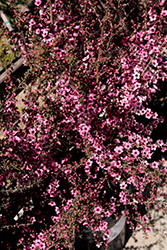Fri & Sat 8am - 8pm
Sun 8am - 7pm
Anytown, USA 12345
fax: 261.787.0463
e-mail: info@successgc.com


Plant Finder

Wiri Shelly Tea-Tree
Leptospermum scoparium 'Wiri Shelly'
Height: 6 feet
Spread: 6 feet
Sunlight:
![]()
![]()
Hardiness Zone: 9a
Other Names: Wiri Shelley, Manuka, New Zealand Tea-Tree
Description:
A bushy, erect compact shrub that shows good drought tolerance; it makes a great hedge or utility plant; pink flowers with dark red centers appear from mid-winter to spring; prune to avoid seed from spreading; flowering stems are great for cutting
Ornamental Features
Wiri Shelly Tea-Tree is covered in stunning pink flowers with dark red eyes along the branches from mid winter to late spring, which emerge from distinctive rose flower buds. The flowers are excellent for cutting. It has attractive dark green evergreen foliage which emerges coppery-bronze in spring. The small narrow leaves are highly ornamental and turn coppery-bronze in the fall, which persists throughout the winter.
Landscape Attributes
Wiri Shelly Tea-Tree is a dense multi-stemmed evergreen shrub with an upright spreading habit of growth. Its relatively fine texture sets it apart from other landscape plants with less refined foliage.
This is a relatively low maintenance shrub, and should only be pruned after flowering to avoid removing any of the current season's flowers. It is a good choice for attracting bees to your yard, but is not particularly attractive to deer who tend to leave it alone in favor of tastier treats. Gardeners should be aware of the following characteristic(s) that may warrant special consideration;
- Self-Seeding
Wiri Shelly Tea-Tree is recommended for the following landscape applications;
- Mass Planting
- Hedges/Screening
- General Garden Use
- Container Planting
Planting & Growing
Wiri Shelly Tea-Tree will grow to be about 6 feet tall at maturity, with a spread of 6 feet. It tends to be a little leggy, with a typical clearance of 1 foot from the ground, and is suitable for planting under power lines. It grows at a medium rate, and under ideal conditions can be expected to live for approximately 20 years.
This shrub does best in full sun to partial shade. It prefers dry to average moisture levels with very well-drained soil, and will often die in standing water. It is considered to be drought-tolerant, and thus makes an ideal choice for xeriscaping or the moisture-conserving landscape. This plant will benefit from an application of bonemeal and/or mycorrhizal fertilizer at the time of planting. It is not particular as to soil type, but has a definite preference for acidic soils. It is somewhat tolerant of urban pollution, and will benefit from being planted in a relatively sheltered location. This is a selected variety of a species not originally from North America.
Wiri Shelly Tea-Tree makes a fine choice for the outdoor landscape, but it is also well-suited for use in outdoor pots and containers. With its upright habit of growth, it is best suited for use as a 'thriller' in the 'spiller-thriller-filler' container combination; plant it near the center of the pot, surrounded by smaller plants and those that spill over the edges. It is even sizeable enough that it can be grown alone in a suitable container. Note that when grown in a container, it may not perform exactly as indicated on the tag - this is to be expected. Also note that when growing plants in outdoor containers and baskets, they may require more frequent waterings than they would in the yard or garden.
